| |
 Main Menu
Main Menu
選 項
Year 2000
Year 2001
Year 2002
Year 2003
| |
Meeting in Weehawken
Date: 9 December 2001
Time: 2:00-5:00 PM
Place: John's House, Weehawkin
Minutes: Matthew, with thanks to John
Attending:
Chang Pei-you, Alan Berkowitz, Stephen Dydo,
Matthew Flannery, Holly Grinnell, Bo
Lawrengren, John Thompson, Marilyn Wong,
Jung-Ping Yuan
Guests:
Elaine Sheng, Suzanne Smith, Yip Mingmei
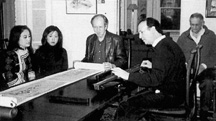
|
|
John plays "Hujia Shibapai("Eighteen Songs of a Nomad Flute"), as Mingmei Elaine,
Syephen, & Matthew listen and view a scroll illustrating the tune
|
The December meeting took place in Weehawken,
New Jersey, at the home of John and his wife Suzanne.
Their home is on a quiet side street, but the Port
Authority Bus Terminal is 10 minutes away and there
are also ferries to the financial district and to the 38th
Street pier in midtown.
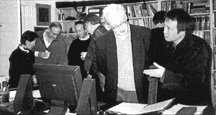
|
|
Marilyn, Matthew, John, Stephen, Bo, Alan, and Jung-ping look over qin books,
manuals, and exhibition catalogs in John's library.
|
The meeting was a festive one, casual, with a
minimal organization of events. After general
conversation that included a discussion of the tools of
calligraphy, an excellent buffet was set out by Suzanne
amplified by treats rounded up by Marilyn from a
specialty foods store. John then toured the members
around his home, which has some traditional Chinese
furniture, including an old wine table and scholar's
table that he uses as qin tables. After members had
gathered upstairs in John's third-floor library, he
reviewed some of the principal sources of qin music as
well as illustrated catalogs of qin exhibitions and of
well-known private collections of qin. But he said that
the most important materials are the collection of
articles and early qin handbooks reprinted in Qinqu
Jicheng and Tong Kin-Woon's Qin Fu (Qin
Storehouse); the qin biographies in Zhu Changwen's
Qin Shi and Zhou Qingyin's Qin Shi Xu and Qin Shi
Bu; and Zha Fuxi's modern index Cunjian Guqin Qupu
Jilan. Most important for background information on
qin melodies are the encyclopedic dictionaries
Zhongwen Dacidian and Hanyu Dacidian. Also
important are many of the classical texts and, where
available, their translations.
Afterwards, in a second-floor
sitting room, Ming-mei gave a
performance of "Ping Sha Luo
Yan ("Geese
Descending to a Sandbank") in
the version in the Jiao An Qin
Pu (Qin Handbook
of the Banana Hut) of 1868.
Eventually, everyone returned
to the first floor, where Stephen
fired up a computer to show us
his preliminary design for a
proposed NYQS website. He
asked for and received
comments and criticisms as to
the present design and where to
go from there. Of particular
concern were how to title
categories of information
accessible at our site and what
kinds of information should go
under each title. Each category
would be accessible via a button
on the home page.
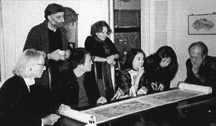
|
|
Holly, Alan, Jung-ping, Suzanne, Mingmei, Elaine, and Stephen view one of John's handscrolls.
|
As the members gathered
around his dining room table,
John discussed paintings and
other illustrated materials that
depict qin performances, a
favorite interest of his. In China, qin players generally
came from the literati class who wrote poems, painted,
and calligraphed. John likens the scholar's traditional
"elegant gathering" to a modem multimedia event, for
it might feature all these arts together. At our meeting,
John tried to show some of the multimedia possibilities
involving scrolls and other art objects.
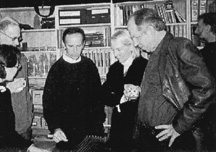
|
|
Marilyn, Matthew, John, Holly Stephen and Alan look over texts in John's library.
|
John estimates (unscientifically) that, if a music
instrument occurs in a Chinese landscape painting,
there is more than a 90% chance it is a qin. Many are
unaware of how common this instrument is in literati
culture, in part because the qin is often shown wrapped
in a case and carried by a scholar or his " qin boy. "
John has copies of many such paintings, including
those lining the stairs to his third floor study and
several new items in scroll format.
Of more interest to
him, however, are paintings that share themes with qin
melodies. Thus, over the player piano in the living
room is a modern painting of two scholars saying
goodbye over a cup of wine inscribed with Wang Wei's
poem "Wei Cheng," which also has been set to the
popular melody "Yangguan Sandie." In
the dining room is a copy of a painting after Su
Dongpo's "Red Cliff" (the original is in the
National Palace Museum, Taipei) inscribed with one of
the two poems on this theme by Su. John has
reconstructed the setting of "Red Cliff" to a qin melody
in theTaiguYiyin (1515). Also
in the dining room is a vase bearing 18 cranes
with the inscription "18 scholars" (in classical Chinese, the pronunciation of
"crane" is like that of "scholar" ).
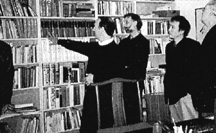
|
|
John points out sources of information on the qin.
|
After
obtaining this vase, John learned the melody
"18 Scholars Ascend Yingzhou" (from
the Faming Qinpu, 1531). In an
upstairs guest room, which also has a qin and
qin table, is a copy of a painting of goblets
floating along a stream at a scholars'
gathering. In this connection, John has
reconstructed the melody "Liu Shang"
("Boating Goblets," a version of the popular
melody "Jiu Kuang") from the
Xilutang Qintong 1549.
Most of his graphic art featuring the qin,
however, is on handscrolls that John displays
when playing a relevant piece. His collection
of paintings emphasizes those with themes of
the melodies in the Shen Qi Mi Pu
(1425), his major research project,
including "Huo Lin," "Yi Lan," "Gao Shan Liu
Shui," "Chu Ge." "Zhi Zhao Fei" and "Qiuyue
Zhao Mooting."
He also has paintings related to later
melodies. Of particular note were two scrolls, each
about 10 yards long, by the Hangzhou artist Bai Yunli.
One is "Hujia Shibapai ("Eighteen
Songs of a Nomad Flute"). The other was "Yu Ge" ("Song of the Fisherman," also in 18 sections).
The 18 sections of each scroll correspond with 18
sections in the qin melodies. The melody
corresponding to the first scroll is "Da Hujia"
in the Shen Qi Mi Pu; while that corresponding to the
second scroll is "Yu Ge" in the Xilutang Qintong. As
John played each section of these two melodies, the
scrolls were unrolled, and Holly read the inscriptions
for each section of the melody in English, Jung-Ping in
Chinese. The "Hujia" scroll is a copy of the version in
the Metropolitan Museum of Art. John had Bai Yunii
copy this work from its reproduction in Eighteen Songs
of a Nomad Flute (Metropolitan Museum of Art). This
work also includes scenes from another version of the
work in the Boston Museum of Fine Arts. The "Yu Ge"
scroll is based on a scroll in the Freer Gallery,
Washington, "Yu Fu Tu" by Wu
Zhen. The scenes in this scroll are
accompanied by poems by Wu Zhen.
These poems, however, do not match the titles
of the qin melody "Yu Ge," so John asked Bai
to do a scroll in a style comparable to Wu
Zhen's but with scene titles from the qin
melody.
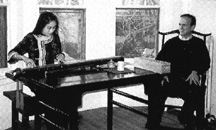
|
|
Mingmei plays "Ping Sha Luo Yan" as John watches.
|
Several members added to Ming-mei's
performance earlier in the meeting by playing
some of their own. Marilyn played "Three
Variations on the Tune "Plum Blossoms," for example, while Jung-Ping
performed "I Gu Ren" ("Memories
of an Old Friend").
Toward the end of the meeting, Jung-Ping
demonstrated the art of calligraphy, inking
examples of the five basic script types. He
brushed characters in zhuan shu (seal
script), Li shu (clerical script), kai shu
(standard script), xing shu
(running script), and cao shu (cursive
script) for the members' appreciation.
Afterwards, there were several parallel
conversation about a number of topics,
especially the types and scheduling of
meetings for 2002. There was some debate as
to whether the Society should hold two public
meetings or conferences rather than the one that was
held in 2001. After some consideration, the consensus
seemed to favor holding just one, probably toward the
end of the year to allow ample time to prepare for it.
Members: Alan J. Berkowitz, Alex Chao, Peiyou Chang, Stephen Dydo, Matthew Flannery, Holly Grinnell, Willow Hai, Shida Kuo, Bo Lawergren, John Thompson, Marilyn Wong Gleysteen, Yuan Jung-Ping
|

